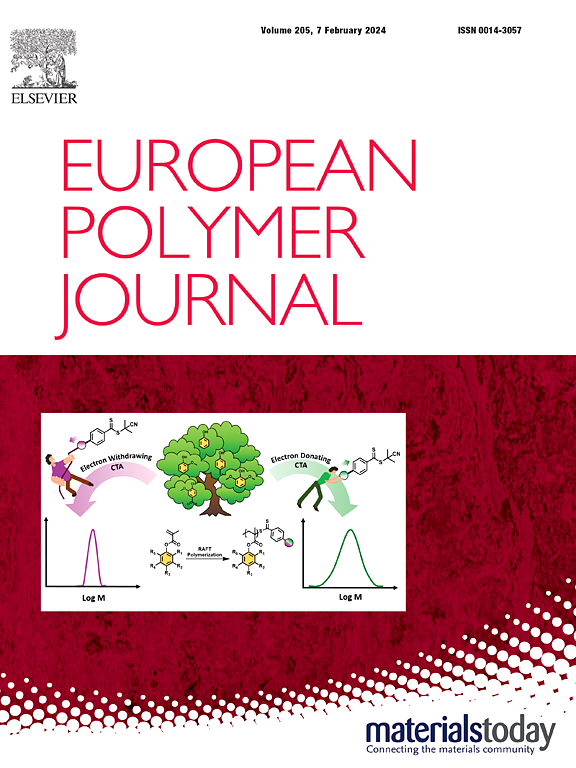Enhanced wound-healing by hydrogel from okra mucilage grafted with Poly-2-Acrylamido-2-methylpropane sulfonic acid (AMPS), a stimuli-responsive polymer
IF 5.8
2区 化学
Q1 POLYMER SCIENCE
引用次数: 0
Abstract
Mucilage, a naturally occurring polymer found in plants, has applications in water filtration, drug delivery, and the food industry. This study aimed to enhance the bioavailability of wound healing medications by modifying okra mucilage with the hydrophilic monomer 2-Acrylamido-2-methylpropane sulfonic acid (AMPS) through free radical polymerization. Various ratios of okra mucilage to AMPS, with ethylene glycol dimethacrylate as a cross-linker and potassium persulfate as an initiator, were tested. The resulting hybrid polymers exhibited biocompatibility and stimuli-responsive behavior at different pH levels. Swelling studies in physiological fluids revealed that the 1:10 okra to AMPS ratio demonstrated the best swelling behavior, which was selected for further in vitro and in vivo evaluations. Thermal analysis, X-ray diffraction (XRD), Scanning Electron Microscope (SEM), and Fourier Transform Infrared Spectroscopy (FT-IR) confirmed the successful polymer modification. At pH 4, the 1:10 cross-linker ratio achieved maximum swelling of 194%. The polymer exhibited 40% drug loading and 77.2% encapsulation efficiency with Calendula officinalis flower extract (CE). In vivo tests showed significant improvements in wound contraction, wound index, and epithelization time. The wound closure in the encapsulated sample was 97.15%, compared to 86.7% in the control. These results suggest that the pH-responsive okra-AMPS polymer system offers a promising controlled-release solution for wound healing.

求助全文
约1分钟内获得全文
求助全文
来源期刊

European Polymer Journal
化学-高分子科学
CiteScore
9.90
自引率
10.00%
发文量
691
审稿时长
23 days
期刊介绍:
European Polymer Journal is dedicated to publishing work on fundamental and applied polymer chemistry and macromolecular materials. The journal covers all aspects of polymer synthesis, including polymerization mechanisms and chemical functional transformations, with a focus on novel polymers and the relationships between molecular structure and polymer properties. In addition, we welcome submissions on bio-based or renewable polymers, stimuli-responsive systems and polymer bio-hybrids. European Polymer Journal also publishes research on the biomedical application of polymers, including drug delivery and regenerative medicine. The main scope is covered but not limited to the following core research areas:
Polymer synthesis and functionalization
• Novel synthetic routes for polymerization, functional modification, controlled/living polymerization and precision polymers.
Stimuli-responsive polymers
• Including shape memory and self-healing polymers.
Supramolecular polymers and self-assembly
• Molecular recognition and higher order polymer structures.
Renewable and sustainable polymers
• Bio-based, biodegradable and anti-microbial polymers and polymeric bio-nanocomposites.
Polymers at interfaces and surfaces
• Chemistry and engineering of surfaces with biological relevance, including patterning, antifouling polymers and polymers for membrane applications.
Biomedical applications and nanomedicine
• Polymers for regenerative medicine, drug delivery molecular release and gene therapy
The scope of European Polymer Journal no longer includes Polymer Physics.
 求助内容:
求助内容: 应助结果提醒方式:
应助结果提醒方式:


